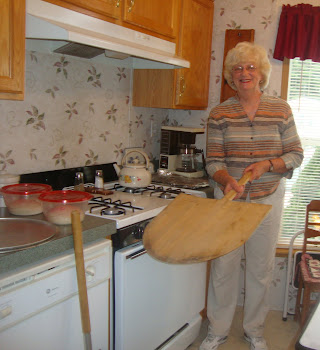This was a high hydration dough and I went about handling the dough something like preparing bread in the Tartine Bread book, with different stretch and folds at different times. I did two stretch and folds Monday evening and another two stretch and folds Tuesday morning. One before I went to market and one at market. I also did another experiment with the dough for the pizza I made yesterday just to see what would happen when mixing at high speeds in my Kitchen Aid mixer. I basically wanted to see if mixing at high speeds would destroy this dough. I really didn’t want to destroy it, but wanted to see what would happen. After the dough was mixed together I turned the mixer on my highest speed and watched how the dough was coming away from the sides of the mixer. I hadn’t added any salt or oil then. All of a sudden the dough became really liquid again. I then turned off the mixer and added the salt and finally the oil. When the salt was added the mixer started picking up on the hook again. Then I only mixed on speed 3 until all oil was incorporated, and even hand kneaded a little of the oil in.
From all the experiments I did with milk kefir before, I knew it could rise any dough, but milk kefir does rise dough slower than other starters or IDY. I think, but don’t know, that is why this dough could be left out at room temperature so long. I think one of my other starters could have also given about the same results.
I don’t know what would have happened with the alveoles, if I would have baked this dough on the deck of my oven. It is always a guessing game, when doing anything with dough. The pizza was baked at around 565 degrees F. in my steel deep dish pan.
This is the formula I used.
http://www.pizzamaking.com/forum/index.php/topic,9946.msg122397.html#msg122397
and
http://www.pizzamaking.com/forum/index.php/topic,9946.msg122436.html#msg122436
Norma
This is a blog about my learning knowledge to make pizza. I have been helped by many people on my journey
Welcome...
There are so many variables that go into making a PIZZA. The hydration of the dough, flour, yeast and many more.. Amounts of any kind of yeast in a pizza can make a big difference. Most recipes posted on the web, use too much yeast in their recipes. What I have found out so far, is either bulk fermenting the dough or cold fermenting the dough will give a better flavor in the crust. I am still experimenting to find different flavors in the crust of pies. In my opinion pizza is all about the best flavor you can achieve in a crust. I still am on the journey about flavors in the crust. Even differences in temperatures in you home or times of the year can influence how much yeast to use. If you want a pizza to develop flavors in the crust, there are many ways to go about achieving this.
Adventure in Pizza Making
There are many ways to go about trying to make any kind of pizzas you want to create. PIZZA making is fun and also you get to eat your finished product. I learned to make all my pizza on http://www.pizzamaking.com/forum/index.php
If you look on pizzamaking.com you can see all the beautiful creations of pizzas members make on this site. Members and moderators help members and guests achieve almost any kind of pizzas they want to create. Since joining this site, my pizza making skills have gone from non-existent to something much better. I invite you to take a look at this site.
Total Pageviews
Subscribe to:
Post Comments (Atom)















No comments:
Post a Comment